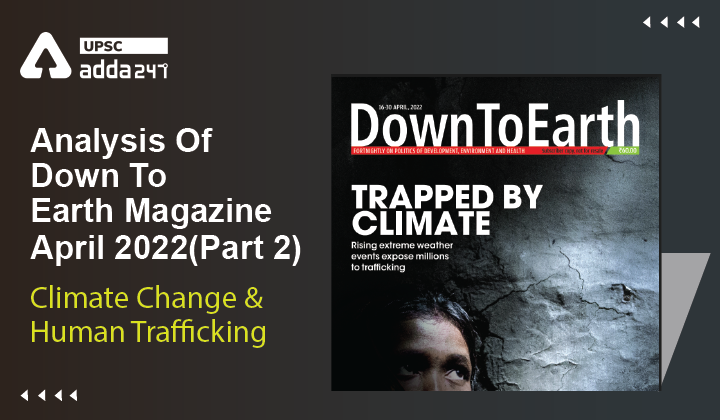Table of Contents
Analysis Of Down To Earth Magazine: ”Climate Change & Human Trafficking”
Relevance
”GS 3: Conservation, Environmental Pollution & Degradation”
Introduction
- International Organization for Migration, found that more people are now displaced due to climate-induced disasters than due to conflicts, reversing a historical trend.
- Disasters and poverty fuel human trafficking.
- An increase in extreme weather events makes millions more vulnerable to this trap.
Relation between climate change & human trafficking
- Disasters lead to a breakdown of social institutions, making food securing and humanitarian supplies ‘difficult’.
- This leaves women and children ‘vulnerable to kidnapping, sexual exploitation and trafficking.
- The UN Environment Programme estimates that globally, human trafficking rises by 20-30 per cent during a disaster.
- Under the UN’s 2030 Agenda for Sustainable Development, human trafficking has been identified as a development challenge that should be eradicated by 2030.
What does the data say?
- Total internal displacement due to disasters, conflicts and violence increased from 31.5 million in 2019 to 40.5 million in 2020, despite containment measures to curb the covid-19 pandemic.
- But some 30.7 million displacements in 2020 were triggered by disasters in 145 countries and territories.
- While storms accounted for 14.6 million displacements and floods for 14.1 million, extreme temperatures displaced 46,000 people and droughts 32,000 people.
- India reported nearly 4 million new displacements due to climate-induced disasters in 2020.
What does Climate Vulnerability Index(2019-20) say about India?
- While coastal states of India are seeing a rapid increase in floods and cyclones brought on by the impacts of climate change, interior regions see slower effects such as droughts.
- As a whole, the country is at severe risk to climate change. Even Maharashtra, which is marked least at risk, has a high score of 0.42 out of 1.
- The growing threat of climate change impacts also increases the instances of displacement and migration, making people more vulnerable to trafficking.
Some worst affected areas of the country
Sundarbans
- South 24 Parganas district, which comprises the Sundarbans, is frequently affected by cyclones.
- Some 37.2 per cent of the people live below the poverty line.
- In the aftermath of a disaster, traffickers target those who have lost their houses and livelihoods.
Gorakhpur
- Surrounded by Kushinagar in Uttar Pradesh and West Champaran in Bihar, which are prone to floods.
- The Rapti and Rohini rivers flood annually during monsoon, making rural residents vulnerable to displacement and trafficking.
Sitamarhi and Gaya
- Sitamarhi sees floods on the Bagmati river after the monsoon every year, which impacts livelihood.
- Gaya district is drought-prone due to rocky terrain.
- People go to Uttar Pradesh and central India to work in brick kilns, leaving their children as targets for traffickers.
Marathwada
- It is a severely drought-prone region whose major crops—sugarcane and cotton—increase water scarcity.
- Poverty-ridden Beed, Osmanabad, Latur and Parbhani districts are major source points from where young girls are trafficked when parents migrate in search of work.



 TSPSC Group 1 Question Paper 2024, Downl...
TSPSC Group 1 Question Paper 2024, Downl...
 TSPSC Group 1 Answer key 2024 Out, Downl...
TSPSC Group 1 Answer key 2024 Out, Downl...
 UPSC Prelims 2024 Question Paper, Downlo...
UPSC Prelims 2024 Question Paper, Downlo...





